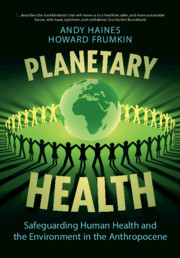Book contents
- Planetary Health
- Reviews
- Planetary Health
- Copyright page
- Contents
- Preface
- Acknowledgements
- 1 Our Changing Planet
- 2 Climate Change
- 3 Pollution, Land Use, Biodiversity, and Health
- 4 Assessing Vulnerability and Risk in the Anthropocene Epoch
- 5 Adaptation and Resilience to Planetary Change
- 6 Addressing Conceptual, Knowledge, and Implementation Challenges
- 7 Health in the Sustainable Development Goals
- 8 Transforming Energy and Industry: Towards a Net-Zero Circular Economy for Health
- 9 Sustaining Urban Health in the Anthropocene Epoch
- 10 Food Systems and Land Use
- 11 The Role of Health Professionals in Fostering Planetary Health
- 12 Sustaining Planetary Health in the Anthropocene
- Index
- References
9 - Sustaining Urban Health in the Anthropocene Epoch
Published online by Cambridge University Press: 01 July 2021
- Planetary Health
- Reviews
- Planetary Health
- Copyright page
- Contents
- Preface
- Acknowledgements
- 1 Our Changing Planet
- 2 Climate Change
- 3 Pollution, Land Use, Biodiversity, and Health
- 4 Assessing Vulnerability and Risk in the Anthropocene Epoch
- 5 Adaptation and Resilience to Planetary Change
- 6 Addressing Conceptual, Knowledge, and Implementation Challenges
- 7 Health in the Sustainable Development Goals
- 8 Transforming Energy and Industry: Towards a Net-Zero Circular Economy for Health
- 9 Sustaining Urban Health in the Anthropocene Epoch
- 10 Food Systems and Land Use
- 11 The Role of Health Professionals in Fostering Planetary Health
- 12 Sustaining Planetary Health in the Anthropocene
- Index
- References
Summary
Urban living is becoming increasingly predominant, with 55% of the world’s population currently living in cities and 68% projected to do so by 2050 (1). While megacities with more than 10 million inhabitants command much attention, they account for less than 10% of the world’s urban population. In contrast, nearly half of all urban residents – over 2 billion people – live in cities with populations under 500,000 (Table 9.1). It is in these smaller cities where population growth rates tend to be highest. The USA, Latin America, and Japan are very highly urbanized but both Africa as a whole and India remain well below 50% urbanized (Figure 9.1). Many low- and lower-middle-income countries in particular are projected to urbanize rapidly in coming decades, with a projected increase of 2.5 billion people in urban areas by 2050 – accounting for essentially all projected human population growth through mid-century.
- Type
- Chapter
- Information
- Planetary HealthSafeguarding Human Health and the Environment in the Anthropocene, pp. 271 - 309Publisher: Cambridge University PressPrint publication year: 2021

